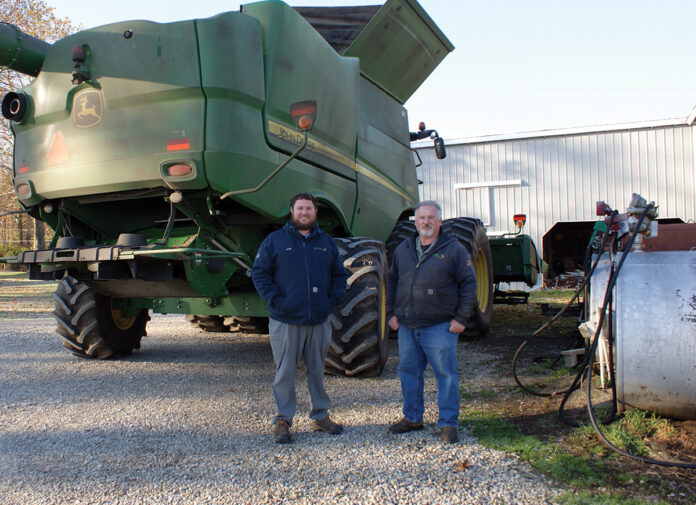
PLAIN CITY, Ohio — Fred Yoder was looking for a grease gun as the sun rose on his farm one day in early November. Rain earlier in the week slowed the harvest, and hundreds of acres of corn needed attention. He learned nearly 40 years ago that maintenance was a cost saver, and saving costs meant better profits at harvest time.
“This is our 10th or 11th combine,” Yoder said. He bought a 200-acre farm from his father in the 1980s. Back then, Yoder planned to finish college and become a teacher; but his dad’s health problems drove him back home.
In the years since, he has experimented with different techniques to improve the soil and increase profits and he has added three more farms, now totaling 700 acres, along the border of Union and Madison counties in west-central Ohio. He also leases an additional 800 acres.
He first observed soil issues as a kid on the farm. When he was about 12, they sold their livestock and planted the previously untilled field. He noted a big difference in the soil between the fluffy, dark earth where the cattle had been, compared to the hard, compacted dirt in the adjoining field.
“Within three years, that [fluffy] soil was just as hard as the other field,” he said. “And I thought, ‘We must be doing something wrong.’” When he started farming, he attended numerous workshops and learned about the “no-till” method of planting crops.
“If the best soil has never been stirred, we’ve got to quit stirring,” he said. “I was planting cover crops before cover crops were cool. The soil is my 401(K).” It represents his investment in the future, as well as his retirement plan.
Family business
Yoder notes there are big changes coming in the farming community. The average age is 58.
His son Josh and daughter Sarah both work for Yoder Ag Services, which sells seed and precision planting equipment.
Josh began actively farming in 2016 when Fred had health issues of his own. In addition to his experience with Yoder Ag, Josh was prepared to advance innovation on the farm. He holds a master’s degree in agricultural economics from Purdue University and an MBA from Ohio State.
Josh focuses on measuring the variables that contribute to higher yields.
“There was an adage I heard over and over in school,” he said. “You manage what you measure.”
They are measuring all the mechanisms behind yield, starting with healthy soil with good nutrition. Protecting soil with a cover crop offers more benefits than preventing erosion. Cover crops build organic matter and put nutrients in the soil. Increased organic matter improves the ability to store and conserve water.
“If you have phosphorus and potassium where they need to be, you build resilience into the system,” Josh said. Their goal is continuous improvement, treating the soil as a monetary investment.
Technology for the future
Yoder Ag Services promotes precision planting technology, which measures the planting process, including seed spacing, moisture content and depth. They can use the data to ensure any differences in eventual yield come from the seed hybrid and not problems with initial planting.
“When we pull out of a field (after planting), we have a map of the counts, including seed skips or double drops,” Fred added. During corn harvest, their John Deere combine continually records moisture content and average bushels per acre.
The data allows them to better evaluate which hybrids are best in different types of soil and other conditions. They look at the agronomic characteristics of different hybrids to ensure the seed type is right for their soil. And they share that knowledge with the customers who count on Yoder Ag Services for their seed.
Keeping dirt in place
Fred realizes some people think the dirt between rows of corn looks pretty, but it can blow away during high winds, and wash away during heavy rains — his goal: no bare soil. Protecting and enhancing the soil can also help mitigate problems with changing weather patterns.
“A few years ago, no one wanted to talk about climate change,” Yoder said. “But they notice a difference in weather patterns.”
Yoder is spreading his cover crop gospel to others. He’s an active member of regional, national and international organizations that work collaboratively and use data to improve farming. With changes in technology and data collection, he hopes to see more bright young people interested in farming.
“Agriculture can be part of the solution to climate change and feed the world,” Yoder said. “Our whole existence depends on topsoil. We can be part of sustainability, provide solutions and make the Earth a better place. The way we get there is through technology and innovation. We don’t want to produce crops like we did 50 years ago. We can do better.”









